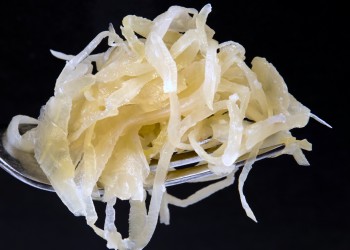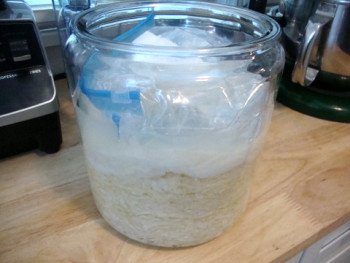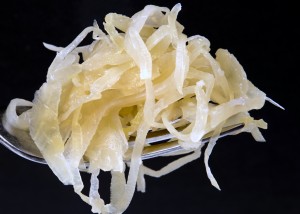
Sauerkraut is German for “sour cabbage,” but is originally a Chinese invention made with rice wine. Sauerkraut is made from finely cut cabbage that has been fermented by various lactic acid bacteria which propagate naturally during the fermentation process. It has a long shelf-life and a distinctively sour flavor, both of which result from the lactic acid that forms when the bacteria ferment the sugars in the cabbage.
Every chef has their own recipe for preparing sauerkraut and this is my personal formula and technique that works for me every time – with no undesirable mold blooms to skim from the surface of the brine during fermentation. Sauerkraut takes roughly 5 to 6 weeks from start to finish, so plan ahead and be patient – the results are worth waiting for.
Ingredients:
• 2 large heads green or red cabbage
• 3 T sea salt, kosher salt or pickling salt
• 3 cups filtered or spring water
• 1 T dried juniper berries (optional)
• 2 tsp caraway seeds (optional)
You will also need:
• 1 gallon wide-mouthed clear glass jar
• cheesecloth
• 2 one-quart zip-lock bags
• plastic wrap
Technique:
Before beginning, make sure the jar has been washed thoroughly with hot, soapy water and rinsed well; or run through the heated cycle in a dishwasher. Wash your hands thoroughly.
In a small saucepan, add 3 cups spring or filtered water and 1 teaspoon of the salt. Bring to a brief boil and remove from the heat to cool until lukewarm.
Remove any loose and damaged leaves from the heads of cabbage and either discard the leaves, save for preparing stock or compost. Split the heads of cabbage lengthwise (from the crown to the core). Cut a “V” shape to remove the tough core from each half.
Place a half head, cut side down, on a clean work surface and using a very sharp knife, begin to slice or “shave” the cabbage as thinly as possible to create very thin, long ribbons. Take your time slicing the cabbage, as very fine shreds will yield the best texture in the finished sauerkraut (personally, I use only the long, thin ribbons for the sauerkraut and save any pieces that are too large or too small for vegetable stock).
Place the shreds into the jar and sprinkle in 2 teaspoons of the salt. Repeat shredding the second half and place in the jar. Sprinkle again with 2 teaspoons salt. Using a potato masher or similar object, pack down the cabbage as firmly as possible. The salt will help draw out the juice from the cabbage to create the brine. If using the juniper berries and/or caraway seeds, sprinkle half over the cabbage.
Repeat with the second head of cabbage, adding 2 teaspoons of salt for each shredded half added to the jar. Pack down the cabbage again. If using the juniper berries and/or caraway seeds, sprinkle the remaining portion over the cabbage.
Fold a double layer of cheesecloth in half and cut to fit into the jar with some excess for tucking. Place on top of the cabbage shreds and using a dull table knife, tuck the cheesecloth snugly around the inner circumference of the jar. This will hold the shreds in place and keep them from floating upwards in the brine. Pour the cooled salted water over the cheesecloth.

Fill a zip-lock bag about ⅔-full of water and seal. Tuck the bag into the second zip-lock bag and seal. The second bag will ensure that no leaks of water occur from the water-filled bag.
Place the water-filled bag into the jar on top of the cheesecloth. The weight of the bag will keep the mass of cabbage completely submerged in the brine during fermentation. If the cabbage is submerged completely, no undesirable mold blooms will occur. Seal the top of the jar with plastic wrap to prevent evaporation of the brine.
Place the jar in a cool place (a basement or cool pantry being ideal). A room temperature of 68 to 72 degrees is best for fermenting cabbage. Formation of gas bubbles after a few days indicates fermentation is taking place. Mark your calendar for 5 to 6 weeks.
Once a week, check the jar. The formation of gas bubbles will sometimes cause the packed shreds to rise in the jar, which can potentially expose the surface to air, thus encouraging undesirable mold blooms. Simply remove the plastic film and re-tuck and push the cheesecloth down around the inner circumference with the edge of a spoon. There’s no need to remove the bag of water; simply work around it (but be careful not to puncture the bag!). Re-seal the top of the jar with plastic wrap.
When fermentation is complete, pack individual mason jars with the sauerkraut and add enough brine to keep the shreds covered with the liquid, while leaving ½-inch of headspace in the jar. Fully fermented sauerkraut can be kept tightly covered in the refrigerator for a few months. The sauerkraut can be eaten raw, which promotes a healthy intestinal flora; or it can be cooked and used in your favorite recipe.

| Servings |
|
|
|

|






